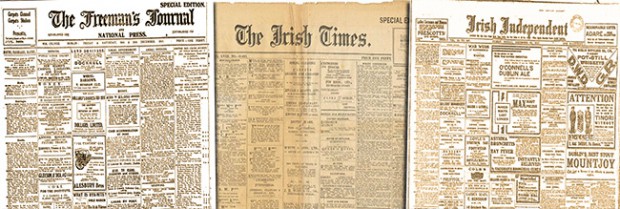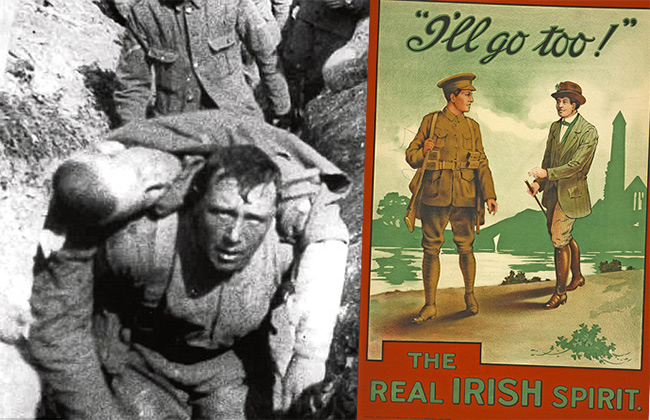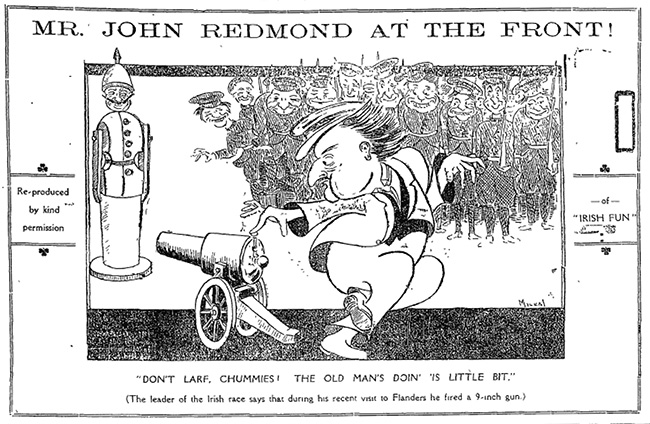1 December 2015 Edition
Christmas 2015 something in common with Christmas 1915

CORRUPTION IN SPORT, unending foreign wars, endless advertisements, and all the Abbey plays written by men. The media issues in 1915 and 2015 have a lot in common. The missing element from the December 1915 coverage is substantial mention of the growing Irish Volunteer movement. Police reports throughout late 1915 reflect the depth of this absent aspect of the news media coverage of the time. On 29 November, the police reports that “this body of Irish Volunteers numbers 10,000 strong, with control of 1,500 rifles, possibly more, thoroughly disloyal and hostile to the British Government”.
A report on 14 December reports that the Volunteers had gained “1,300 new members during the month” and “a party of 800 held military manoeuvres at Artane”. On 18 December, the Under Secretary to the Chief Secretary (one of the British Government’s highest-ranking officials in Ireland) wrote that “the active Irish Volunteer numbers had increased to 13,500” and “each group of these is a centre of revolutionary propaganda”.
Irish newspapers, 1915 and 2015
Ireland in the national media of December 1915 is a different country from the revolutionary hotbed portrayed in police reports.
Support for the British Government and its hungry imperialist ambitions reflected in the position of the national Irish newspapers at the time jars with the growing number of supplements being printed in Irish papers in 2015.
The Irish Independent has had three 1916 supplements in recent weeks. As An Phoblacht goes to print, the latest Irish Times instalment has been published, called “Dragons Stirring — Ireland six months before the Rising”.
There are no dragons in the Irish newspapers at Christmas 1915.

• Support for the British Government's imperialist ambitions are reflected in the main national Irish newspapers of 1915
First World War
All across the pages of the Irish Independent, Examiner, Times and Freeman’s Journal the greatest amount of coverage is given over to the First World War. The class bias of the time is shown by dividing war dead into “officers” and “rank and file”.
There’s a stream of reports on the travel plans of wealthy aristocrats such as “the Earl of Bective and his brother Lord William Taylor” who have “joined the Marchioness of Headfort at Headfort House Kells for Christmas”. All very jolly.
The Indo on Christmas Eve reports the views of a Fr Vaughan, who recently had “visited the Front” and claimed:
“No man who is an impartial student of history would dare to deny that both on land and sea the Celtic race is serving the British Empire with a gallantry, dash and daring that falls nothing short of heroism. You would think that Paddy was born to fight.” All very jolly also unless you’re one of the ‘poor bloody infantry’ maimed or slaughtered in Flanders’ fields serving the Empire.
(Fr Vaughan, of course, was born to a higher calling safe at home again.)
The Christmas Eve papers do give some flavours of a different Ireland, though.
While the Irish Examiner reports on the forming of a Fermoy committee for British Army recruitment (alongside a report of a meeting of the Blarney Total Abstinence Athletic Society!), the Freeman’s Journal tells of a meeting in Castlemahon of the United Irish League (motto: “The Land for the People”). The papers that the nationalist UIL “now had a number of physical force men declaring they were organising to defend Ireland”. And many papers have negative comments on Irish Parliamentary Party leader John Redmond.
One common story across papers is the Football League suspensions on 23 December of Manchester United and Liverpool players for their involvement in a match fixing scam the previous April when United had won 2-0. Subsequently, seven players were banned for life.

• A cartoon in The Kerryman from Christmas 1915 on John Redmond's visit to Flanders
The people’s press
On the same day, James Connolly writes in The Workers’ Republic that, on 21 December 1796, “a French fleet entered Bantry Bay” but General Emmanuel de Grouchy decided not to land and then a storm forced the French fleet to disperse. Connolly ends with the declaration: “Christmas week 1796, Christmas week 1915 — still hesitating.”
Connolly’s Workers’ Republic was one of many alternative publications giving a different view of Irish political life.
The Irish Volunteer (copies of which are currently being carried on An Phoblacht’s website) is another alongside Forward, The Irish Citizen, Eye Opener, Searchlight, and Century.
It is sadly notable that, in the 1916 Rising, three editors of these magazines were executed by British Army Captain Bowen-Colthurst: Thomas Dickson (Eye Opener), Patrick MacIntyre (Searchlight) and Francis Sheehy Skeffington (Irish Citizen).
Among the other writers executed in the aftermath of the Rising was Pádraig Pearse, who went to the firing squad owing the Irish Times 18 pounds and 10 shillings.
Unpaid advertisements for his St Enda’s school that were published in the paper are an apt epitaph for Pearse’s relationship and that of Irish republicanism with the Times. The paper opposed the republican movement that Pearse was part of but were still willing to sell him advertising space.
• This article was completed using the Irish Newspaper Archive, the Irish Times Archive, the National Library of Ireland database, Volume Two of James Connolly’s Collected Works, The 1916 Rebellion Handbook, and the letters of Pádraig Pearse.




